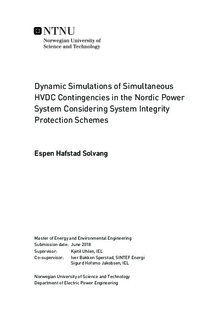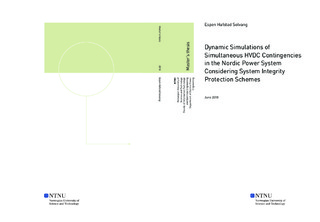| dc.description.abstract | Individual HVDC links connecting the Nordic power system to other synchronous systems may carry gigawatts of power. For the transmission system operators, who must maintain power balance to operate the grid at 50.0 Hz, the outage of such HVDC links may lead to large, undesirable frequency swings due to large power imbalances after an outage, where lower system inertia will lead to larger frequency swings.
The extraordinary event of simultaneous outages of multiple HVDC links is highly unlikely, but may lead to consequences in the power grid that are unacceptable. In this thesis, the consequences of such an event are considered for the Nordic power system with an emphasis on system frequency response and the ability of barriers in the form of System Integrity Protection Schemes, or corrective actions, to curb the most critical frequency excursions. The ability of generator primary response as well as corrective actions such as Under-Frequency Load Shedding, HVDC Emergency Power and Demand-Side Response to improve the frequency response is considered. Only outages of links that are importing power are examined.
The model used is the aggregated network model Nordic 44. The PSS\textregistered E software performs the simulations interfaced with Python using the Psspy API. An assortment of cases are studied; first, event trees are used with corrective actions to identify the ability of different corrective actions to affect the system frequency response for higher and lower inertia scenarios following outages of North Sea Link and NordLink. Thereafter, the impact of locality in terms of where the simultaneous HVDC link outages occur is studied in an attempt to identify critical consequences and vulnerabilities of the power system.
Results indicate that the frequency drop will be very large and perhaps unmanageable when the system inertia decreases. If there are insufficient primary reserves, the system is bound to collapse. However, Demand-Side Response has significant potential to contain the frequency decline if time-delay for Demand-Side Response is low. In several cases, voltage decline in the south of Sweden leads to system separation and limits ability of the power system to withstand the simultaneous HVDC outages. Current construction of HVDC links may thus be contributing to future voltage instability in Sweden. Use of frequency-based corrective actions does not affect the voltage issues in southern Sweden, and voltage-based corrective actions or extra measures for voltage stabilization in Sweden may be necessary.
A recommendation following the obtained results is to emphasize low activation time-delay in projects and future implementation of Demand-Side Response, as this will allow realization of the potential of Demand-Side Response in frequency containment. As construction of new HVDC links may increase the rate of occurrence of large HVDC link outages, it is also recommended that investments in construction of HVDC links are accompanied by investments in voltage stabilizing measures in the south of Sweden. The results should be verified by tuning of the N44 model towards voltage response and by the detailed network models of the transmission system operators. | |

